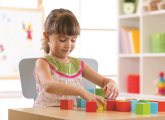Natasha Wood shares practical ideas for supporting EAL children in your Early Years setting…
When EAL children join your setting, your primary concern is always (as it is with all children) to ensure that they feel safe and happy in their new surroundings.
You want them to quickly integrate into their environment, make friends and over time be able to use English as confidently as they use their first language.
To do this successfully you need to provide lots of opportunities for them to play and communicate with their peers. Here’s a few ideas to get you started:
You’ll need:
Invite EAL children to make their own houses using the materials provided. Show them how they can glue the lollipop sticks together to represent a house. For younger children, have some pre-prepared houses ready.
Give each child a piece of paper and invite them to draw pictures of their families. Talk about who they have in their family and the role they play. Encourage children to listen to each other, ask questions and be respectful.
Help children to stick their picture onto their house, then make a display of all their creations, showing all the different backgrounds and cultures that make up the class.
You’ll need:
In advance, send home a letter asking parents to write down their child’s favourite book or story. If it’s from another country, ask if they would mind bringing a copy of the book in.
Print out the name of the book and encourage EAL children to draw pictures to match it.
Fill the box with objects and pictures that relate to the book and where it comes from, for example fabric, colour swatches, scented bottles, maps, photos of people from the country, music recorded onto sound buttons, toys and jewellery.
Display the book with the box so that children can read the book and explore the objects together.
What you need:
It’s so important that children are exposed to different music, songs and instruments from around the world. Choose songs and music that reflect the backgrounds of your EAL children. Play them regularly while children carry out all kinds of activities, such as drawing, painting, during dance sessions, role play or when outside.
By being able to communicate freely through music, children learn to express themselves with confidence. This activity also helps children to empathise with others from different backgrounds and cultures.
As well as helping to maintain focus and concentration, music and movement can soothe, distract and help young children to socialise.
You’ll need:
Fill each box with objects and photographs from different countries. Decide how you want to introduce your boxes to children, for example, a continent or country per week, after a story or painting, or using a piece of music or clothing from the corresponding place.
Start by looking at the map to find where the country or continent for each box is and its relation to where the children live.
Practise saying the appropriate greeting. Model the language first and encourage children to repeat it to you.
One at a time, invite children to choose something from the box and give them the opportunity to talk about what they have selected. Talk together about differences and similarities between different cultures. End by saying farewell in the appropriate language.
Although it is important to remember that there is no set pattern or way for EAL children to learn an additional language, there is a general guidance that you can have in mind to support them in the early stages.
At this stage, EAL children should not feel pressurised to talk but adults should continue to involve them and pick up on any non-verbal responses, for example, pointing, nodding, smiling.
In addition to or alongside non-verbal responses children might echo single words or repeated common phrases. When they demonstrate this, continue to praise them and offer encouragement.
Children may start to join in with songs or stories and start to develop ‘formulaic’ language, for example, ‘my turn’, ‘home time’, ‘I go toilet’. They will soon begin to use simple questions, names and responses, for example, ‘yes please’, ‘no thank you’, ‘I feel fine’.
Next, they will develop independent phrases that reflect their wants and needs and begin to use adjectives, nouns and verbs in their speech. Finally, children will become confident in using longer sentences.
Natasha Wood is an early years leader, SENCO and author, who has worked in early years education for over ten years.
This article is an edited extract from 50 Fantastic Ideas for Children with EAL (£12.99, published by Bloomsbury).

Observations – using a strengths-based approach
Editors picks

Outdoor maths – Eco-friendly ideas for cold days
Editors picks
